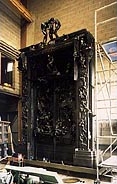Rodin Works: the Gates of Hell |
|
The
scenes presented at 'The Gates of Hell' were inspired by Dante Alighieri's Divine Comedy of the begining of the
14th century, which had been a popular
subject for numerous painters and sculptors - William Blake, who illustrated Dante's
tale in 1820, John Flaxman, Delacroix ('The Barque of Dante', 1822),
Ingres, Jean-Baptiste Carpeaux ('Ugolino', 1863) - and for writers like
Chateubriand, Stendhal, Balzac and Hugo.
Although the Purgatorio and Paradiso parts of the Commedia
should also be taken into account, most of Rodin's creation is dedicated to the Inferno.
Rodin enriched the story with his own fantasy and visions
from 'Les Fleurs du Mal' of 1857 by Charles Baudelaire. In these poems,
Baudelaire had described man as haunted by passions, that both delight and
torment him. In his 'Gates', the sculptor also added elements from Ovid's Metamorphoses,
like the Centaurs in the tympanum, abducting a number struggling women. "There is no intention of classification, or method of subject, no scheme of illustration or intended moral purpose. I followed my imagination, my own sense of arrangement, movement and composition. It has been from the beginning, and will be to the end, simply and solely a matter of personal pleasure." [Rodin in conversation with Truman Bartlett, 1887/8
"My idea was not to interprete Dante, although I was glad to use the Inferno as a starting point, because I wanted to do something with small-scale nude figures. I was accused of taking casts from life [...] to prove once and for all that I could model after nature as well as anyone, I resolved, in my naiveté, to make the sculptures on the door smaller than life-size." [Rodin in conversation with Truman Bartlett, 1887/8, p.233, quoted by Grunfeld, Rodin - A biography, p. 182; Jarrassé, p. 60; Elsen, Rodin, MoMa 1963, p. 35 ] Already in 1875, Rodin, who was probably familiar with the
translation by Rivarol, had started dealing with Dante's work and had
created a series of drawings, accentuated by thick dark lines. Although the artist later stated he
had given up working after the drawings, Aida Audeh has demonstrated that
Rodin's must have been so saturated with Dante's text, the well-known
medieval illustrations and his own sketches that all later sculptural
works must be seen in the light of this tradition and preparatory work. The first architectural drafts for 'The Gates' show a series of narrative scenes arranged in two sets of each four separate picture windows. Rodin's initial idea was to structure the doors like 'The Gates of Paradise' of Lorenzo Ghiberti at the Baptisterium in Florence and tell the story in different plates, rhythmically arranged with a different focus of light. Later, inspired by Michelangelo's ceiling of the 'Sistine Chapel', Rodin simplified this concept. As the figures populating 'The Gates' started to emerge from the background and gained more volume, Rodin abandoned the horizontal barriers between the sections; it seemed as if the individual scenes were now floating in a sea of fire. Whereas in Dante's Inferno, every class of sinners is imprisoned in his specific ring and circle, in the flames of Rodin's 'Gates' these compartments have been molten down and fused. Despite this grandiose flux, the protagonists remain isolated in their despair, each of them driven by their relentless passion. Dante's medieval categorizing structure gives way to a more universal drama of mortal mankind, "(...) adrift in an empire of night (...) damned on both sides of the tomb" [Elsen, Rodin, MoMa, p. 45]; instead of a Christian morality, Rodin confronts us with the dilemmas of modern man, for whom all clear orientation of values has gone astray.
Later, 'The Shades' were placed on top of the door and point to the center below, where 'The Thinker' - also called 'The Poet', representing Dante himself - was placed in front of the box-like tympanum. In 1885, Gustave Mirbeau published the first description of the work in progress: "The portals two doors are
divided into two panels, each separated by a group that forms a sort of
doorknocker. On the right-hand door, Ugolin and his sons; on the left,
Paolo and Francesca da Rimini. ... Above the groups, Rodin has placed
bas-reliefs from which protrude figures in high relief and scenes in
mezzo-relievo that give his work an extraordinary sense of perspective.
Each door is surmounted by tragic masks, heads of furies and terrifying,
captivating allegories of sinful passion." As we learn from this description, Paolo Malatesta and Francesca da Rimini,
the illicit love couple that was caught and stabbed by Francesca's jealous
husband, Still in 1888, Bartlet described 'Ugolino' as the "chief point of interest of the right-hand part of the door". But photos by made by Jessie Lipscomb in September 1887 prove that by then, the Ugolino group had already been moved to the left wing; 'The Kiss' had been replaced by another group, 'Fugit Amor'. Whereas the characters of Ugolino and of Paolo & Francesca can clearly be identified in Dante's 'Divine Comedy', Rodin created an additional host of over 200 figures, representing the damned souls in the underworld, writhing to escape the torments of Inferno. Judith Cladel described this impressive scenery as follows: "Carried away by this marvelous technique, the spirit of the visitor succumbs; it follows this ascending movement of the doorposts, to lose itself in the sorrowful dream sculptured on the tympanum. On the panel writhe the clusters of human figures, the eddies of the multitude of damned souls pursued by the rage of the elements, by the devouring tongues of the infernal fire, by the frozen waters, by the wind that tears them and stings them."
"...the dizzy whirl, the falling through space, the groveling on the face of the earth of a whole wretched humanity obstinately persisting and suffering, bruised and wounded in its flesh, saddened in its soul, crying aloud its griefs, harshly laughing through its tears, chanting its breathless fears, its sickly joys, its ecstatic sorrows." The whole project as such was blasting the framework of a publicly commissioned work that should serve as a an architectural element only. The portal, which initially had a size of 4.5 x 3.5 m (as can be deducted from Rodin's 1881 letter to Turquet, and a carpenter's bill of January 1881 for the wooden frame ), finally reached dimensions of 7.5 m x 4 m . To facilitate his intensive work - Rodin had planned to complete 'The Gates' within three years - the artist was given one of the state-owned studios in the Dépôt des Marbres at the Rue de l´Université with their high ceilings. In July 1888, Rodin moved to studio M; in 1883 he was given Studio H for himself, in 1890 he also occupied Studio J, where he continued to work on 'The Gates of Hell'. The original budget of 8,000 FF was increased several times till it reached the sum of 30,000 FF in 1888, of which Rodin actually received 25,700 FF in eight installments from 14 Oc. 1880 till 31 March 1888. Only to prepare and clean his plaster model for the 1900 exhibtion, Rodin did pay his assistants 32,438.85 FF. The fact that the construction project stranded only seems to have propelled Rodin's vision and energy. Though the sculptor by 1887 must have recognised that the Musée d'Arts Décoratifs would never be built , he continued working on 'The Gates of Hell' - altogether over nearly 40 years. The portal can be considered as his life-project that recorded all the different styles and subject matters emerging throughout his artistic life, a Gesamtkunstwerk in the Wagnerian sense , both experimental workshop and official representation, a bridge between the private and the public site of Art. In this archive of forms - 'my Noah's Ark', as he called it himself - Rodin would store his sculpural sketches, develop and adapt them; often, he would remove them again and present the figure or group as a work in its own right. 'The Kiss' - shown for the first time in the Gallery Georges Petit in Paris in 1887 as an autonomous work, named 'The Lovers', then in Brussels the same year - is only one of many works Rodin originally created as figurines or small reliefs for 'The Gates', then became autonomous statues and eventually were enlarged to monumental dimensions or translated into marble. Other well-known works derived from Rodin's life-long obsession with 'The Gates' are 'The Caryatid', 'The Prodigal Son', 'Sorrow', 'Crouching woman', 'I am Beautiful', 'The Martyr', 'Damned Women', 'Kneeling Fauness', 'Standing Fauness', 'She who was the Helmetmaker's beautiful Wife', 'Glaucus', 'Polyphem'. "All of those who had been able to admire in the artist's studio the finished studies and those in course of execution agree in saying that this door will be the greatest work of the century."
Félicien Champsaur published his impression in Le Figaro of 16 Jan. 1886, repeating Mirbeau's description almost litterally. Instead of exhibiting 'The Gates of Hell' at the Universal Exhibition of 1889, the centenary of the French Revolution , Rodin showed his 'studies' at the exhibition he held together with Claude Monet at the Galerie Georges Petit. The visitors were amazed by.. "... a great number of these small figures pulsing with life which he modestly refers to as studies, but which were actually in the process of revolutionizing contemporary sculpture despite their small dimensions" [Arsène Alexandre, in Paris, 21 June 1889, reprint of the complete article in Claude Monet - Auguste Rodin, centenaire de l'exposition de 1889, Musée Rodin, 1989, p. 220]. In his article for Les Lettres et Les Arts, Geffroy wrote: "The Gates of Hell is the gathering, in eventful motion, of the instincts, the fatalities, the desires, the despairs, of everything that cries out and groans in man. The poem of the Ghibelline has not retained any local color but instead has lost its narrowly Florentine meaning; it has been, as it were, stripped and expressed synthetically, like an anthology of the unchanging aspects of the humanity of all countries and of all times." [Gustave Geffroy, Le Statuaire Rodin, in: Les Lettres et les Arts, Paris 1 Sept. 1889, quoted by John Tancock, 1976, p. 96; reprint of French text as adapted for 1889 catalogue in Monet-Rodin retrospective catalogue, 1989, p. 59-69.]
Only in 1900, at the grand Rodin retrospective in Paris, Place d'Alma, 'The Gates' was shown to the general public - still as a plaster model. In this version, however, many of the projecting figures had been eliminated; it was during this period that the Master had begun stripping his works of narrative detail, trying to reduce his sculptural statement to the essence of shape, motion and space, often leaving nothing more but a fragment. After the World Exhibition, the plaster was finally returned to Meudon. Rodin wanted it to be deposited nearby, though he had no time to give the work the final touch; in 1904, a Goverment document indicated the artist would need another three or four years to implement further modifications. For this reason, the budget of 35,000 FF reserved in August 1885 for bronze casting was cancelled.
|
|
|
|
|
Notice:
Museum logos appear only as buttons linking to Museum Websites and do not
imply any |
|
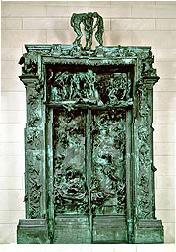 In 1880, just after the State purchased 'The Age of Bronze' in plaster and
bronze, Rodin, through his contacts with State Undersecretary Turquet, received a commission for a portal of the proposed Musée des Arts Décoratifs
on the Cour des Comptes, ravaged in 1871.
In 1880, just after the State purchased 'The Age of Bronze' in plaster and
bronze, Rodin, through his contacts with State Undersecretary Turquet, received a commission for a portal of the proposed Musée des Arts Décoratifs
on the Cour des Comptes, ravaged in 1871.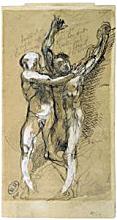 Just like he created his St. John in over-lifesize
dimensions to repudiate the accusations of surmoulage raised in connection
to the 'Age of Bronze', Rodin this time choose to design a great number of
small figures:
Just like he created his St. John in over-lifesize
dimensions to repudiate the accusations of surmoulage raised in connection
to the 'Age of Bronze', Rodin this time choose to design a great number of
small figures:
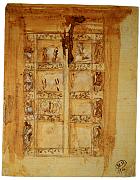
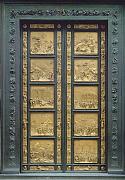
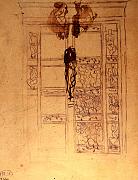
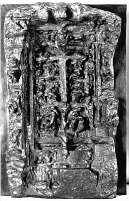 The
first maquette (1880) already shows the asymmetric design, in which the
straight outlines are intercepted by human forms. The third maquette (late
1880) comprises only three partss: the lintel and the two doors. Adapted to the increased spatial character of the figures, the entire
framework has grown more massive.
The
first maquette (1880) already shows the asymmetric design, in which the
straight outlines are intercepted by human forms. The third maquette (late
1880) comprises only three partss: the lintel and the two doors. Adapted to the increased spatial character of the figures, the entire
framework has grown more massive.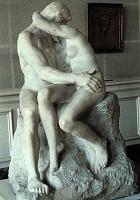 dominate the left wing, as "lovers doomed to be forever
locked in each other's embrace though never to slake their passion".
Mirbeau described a seated Francesca with
"her arms around her lover's neck, abandoning herself to Paolo's
kiss and embrace with a movement at once passionate and chaste."
Obviously, Mirbeau had seen the first version of the famous
dominate the left wing, as "lovers doomed to be forever
locked in each other's embrace though never to slake their passion".
Mirbeau described a seated Francesca with
"her arms around her lover's neck, abandoning herself to Paolo's
kiss and embrace with a movement at once passionate and chaste."
Obviously, Mirbeau had seen the first version of the famous 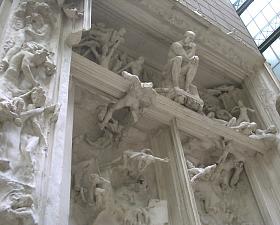 Despite
the atmosphere of doom and despair, the protagonists do not appear as the
emaciated souls described by Dante; apart from a single skeleton in the
Tympanum and a series of "unbaptised children", all figures
represent men and women at the 'ideal age' of ca. 30 (Audeh). As Dominique Jarassé notes, the male bodies are
rather athletic, the female figures sensual: it is difficult to tell,
if their bodies are twisted by agony or by lust. The whole panorama has an
sexual undertone, Thanatos mingles with Eros, the borders between history,
poetry, legend and dream are diluted and transgressed in a vortex of anxiety
and passion. Already Gustave Geffroy pointed out this ambiguity:
Despite
the atmosphere of doom and despair, the protagonists do not appear as the
emaciated souls described by Dante; apart from a single skeleton in the
Tympanum and a series of "unbaptised children", all figures
represent men and women at the 'ideal age' of ca. 30 (Audeh). As Dominique Jarassé notes, the male bodies are
rather athletic, the female figures sensual: it is difficult to tell,
if their bodies are twisted by agony or by lust. The whole panorama has an
sexual undertone, Thanatos mingles with Eros, the borders between history,
poetry, legend and dream are diluted and transgressed in a vortex of anxiety
and passion. Already Gustave Geffroy pointed out this ambiguity: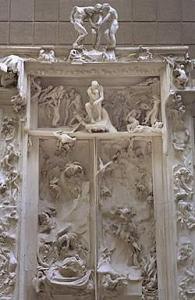 The various figures and groups, modelled separately,
were mounted on a wooden frame in 1882, to preview the total composition.
In June 1884, Rodin asked his founder Eugène Gonon to estimate the costs
of a bronze cast. On 20
August 1885, 35,000 FF for a bronze cast to be executed by the Bingen
Foundry were reserved by the State - but never called for.
The composition, by that time still showing 'The Kiss' on the left wing,
continued to raise the sculptor's discontent. A few friends and art connoisseurs like Edmond de Goncourt and Félicien
Rops were invited to see the plaster. Octave Mirbeau commented the
development of Rodin´s studies with enthusiasm:
The various figures and groups, modelled separately,
were mounted on a wooden frame in 1882, to preview the total composition.
In June 1884, Rodin asked his founder Eugène Gonon to estimate the costs
of a bronze cast. On 20
August 1885, 35,000 FF for a bronze cast to be executed by the Bingen
Foundry were reserved by the State - but never called for.
The composition, by that time still showing 'The Kiss' on the left wing,
continued to raise the sculptor's discontent. A few friends and art connoisseurs like Edmond de Goncourt and Félicien
Rops were invited to see the plaster. Octave Mirbeau commented the
development of Rodin´s studies with enthusiasm:
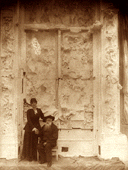 In 1898, nine years later, Henri Frantz reported, "The artist´s
dream ist to have the jambs carried out in marble and the two doors in bronze. But although the collection
of the Musée des Arts Décoratifs
was deposited in the Marsan Pavillon of the Louvre by
1899, Rodin felt the architects involved were not interested in placing
his giant (23" high) portal there .
In 1898, nine years later, Henri Frantz reported, "The artist´s
dream ist to have the jambs carried out in marble and the two doors in bronze. But although the collection
of the Musée des Arts Décoratifs
was deposited in the Marsan Pavillon of the Louvre by
1899, Rodin felt the architects involved were not interested in placing
his giant (23" high) portal there .
